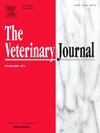Quantifying the carbon footprint of canine breed-specific surgical care in a veterinary referral setting
IF 3.1
2区 农林科学
Q1 VETERINARY SCIENCES
引用次数: 0
Abstract
Objective
To develop and apply a calculator to quantify the carbon footprint of breed-specific surgical care in dogs, from hospital admission to discharge, in a veterinary referral setting.
Materials and methods
Breed-specific procedures were defined as surgeries performed uniquely or predominantly in particular breeds due to inherited or conformational pathology, as identified by the relevant clinical services.
All dogs undergoing breed-specific procedures at a UK veterinary referral hospital over an eight-month period were prospectively studied. Data collected included procedure type, diagnostic imaging, anaesthesia, pharmaceuticals, surgical waste, travel distance, and personal protective equipment use. Published carbon conversion factors were applied to calculate the carbon footprint (kg CO₂e) for each component of care and the total per-patient emissions.
Results
Data were collected from 41 patients undergoing breed-specific surgeries. The mean carbon footprint per patient was calculated to be 103 kg CO2e (standard deviation ± 47.5, range 33–220 kg CO2e). Mean carbon footprint per patient for breed-specific procedures was; BOAS 100 kg CO2e (standard deviation ± 36.4, range 49–174 kg CO2e), medial canthoplasty 55 kg CO2e (standard deviation ± 20.3, range 33–89 kg CO2e), screw tail caudectomy 120 kg CO2e (standard deviation ± 22.6, range 104–136 kg CO2e), ‘Y’ fracture 159 kg CO2e (standard deviation ± 48.2, range 103–211 kg CO2e), ‘Y’ fracture and prophylactic humeral transcondylar screw 200 kg CO2e (standard deviation ± 28.9, range 180–220 kg CO2e) and prophylactic unilateral or bilateral humeral transcondylar screw 99 kg CO2e (standard deviation ± 15.9, range 84–115 kg CO2e) (Table 2). The largest contributors were pharmaceuticals excluding volatile agents (mean 55 kg CO₂e, 40–67 % of procedure-based emissions), owner travel (mean 19 kg CO₂e, 9–28 % of procedure-based emissions), and volatile agents (14 kg CO₂e, 8–24 % of procedure-based emissions). Diagnostic imaging accounted for 6 kg CO₂e (0–8 % of procedure-based emissions).
Conclusions
Breed-related procedures generate substantial carbon emissions, with pharmaceuticals and owner travel being major contributors. These findings provide a foundation for identifying environmentally impactful practices and support efforts to improve sustainability in referral veterinary care. This study also prompts broader ethical reflection on the environmental cost of inherited breed disorders, offering a new dimension to discussions on animal welfare, responsible breeding, and sustainability in companion animal medicine.
量化碳足迹犬品种特定的外科护理兽医转诊设置。
目的:开发和应用一个计算器来量化从入院到出院的兽医转诊设置中犬种特定手术护理的碳足迹。材料和方法:品种特异性手术被定义为由于遗传或构象病理而对特定品种进行的独特或主要的手术,并由相关临床服务确定。所有在英国兽医转诊医院接受特定品种手术的狗在8个月期间进行了前瞻性研究。收集的数据包括手术类型、诊断成像、麻醉、药物、手术废物、旅行距离和个人防护装备的使用。应用已公布的碳转换因子来计算每个护理组成部分的碳足迹(kg CO₂e)和每位患者的总排放量。结果:收集了41例接受品种特异性手术的患者的数据。计算每位患者的平均碳足迹为103kg CO2e(标准差±47.5,范围33-220kg CO2e)。每位患者在特定品种手术中的平均碳足迹为;BOAS 100kg CO2e(标准差±36.4,范围49-174kg CO2e),内眦成形术55kg CO2e(标准差±20.3,范围33-89kg CO2e),螺钉尾尾切除术120kg CO2e(标准差±22.6,范围104-136kg CO2e),“Y”型骨折159kg CO2e(标准差±48.2,范围103-211kg CO2e),“Y”型骨折及肱骨经髁预防性螺钉200kg CO2e(标准差±28.9,范围33-89kg CO2e)范围180-220kg CO2e)和预防性单侧或双侧肱骨经髁螺钉99kg CO2e(标准差±15.9,范围84-115kg CO2e)(表2)。最大的贡献者是药品,不包括挥发性剂(平均55kg CO₂e,占基于程序的排放量的40-67%)、业主旅行(平均19kg CO₂e,占基于程序的排放量的9-28%)和挥发性剂(14kg CO₂e,占基于程序的排放量的8-24%)。诊断成像的二氧化碳排放量为6kg(占手术排放的0-8%)。结论:与品种相关的程序产生大量的碳排放,药品和业主旅行是主要贡献者。这些发现为确定对环境有影响的做法和支持提高转诊兽医护理可持续性的努力提供了基础。这项研究还促进了对遗传品种疾病的环境成本的更广泛的伦理反思,为讨论动物福利、负责任的育种和伴侣动物医学的可持续性提供了一个新的维度。
本文章由计算机程序翻译,如有差异,请以英文原文为准。
求助全文
约1分钟内获得全文
求助全文
来源期刊

Veterinary journal
农林科学-兽医学
CiteScore
4.10
自引率
4.50%
发文量
79
审稿时长
40 days
期刊介绍:
The Veterinary Journal (established 1875) publishes worldwide contributions on all aspects of veterinary science and its related subjects. It provides regular book reviews and a short communications section. The journal regularly commissions topical reviews and commentaries on features of major importance. Research areas include infectious diseases, applied biochemistry, parasitology, endocrinology, microbiology, immunology, pathology, pharmacology, physiology, molecular biology, immunogenetics, surgery, ophthalmology, dermatology and oncology.
 求助内容:
求助内容: 应助结果提醒方式:
应助结果提醒方式:


